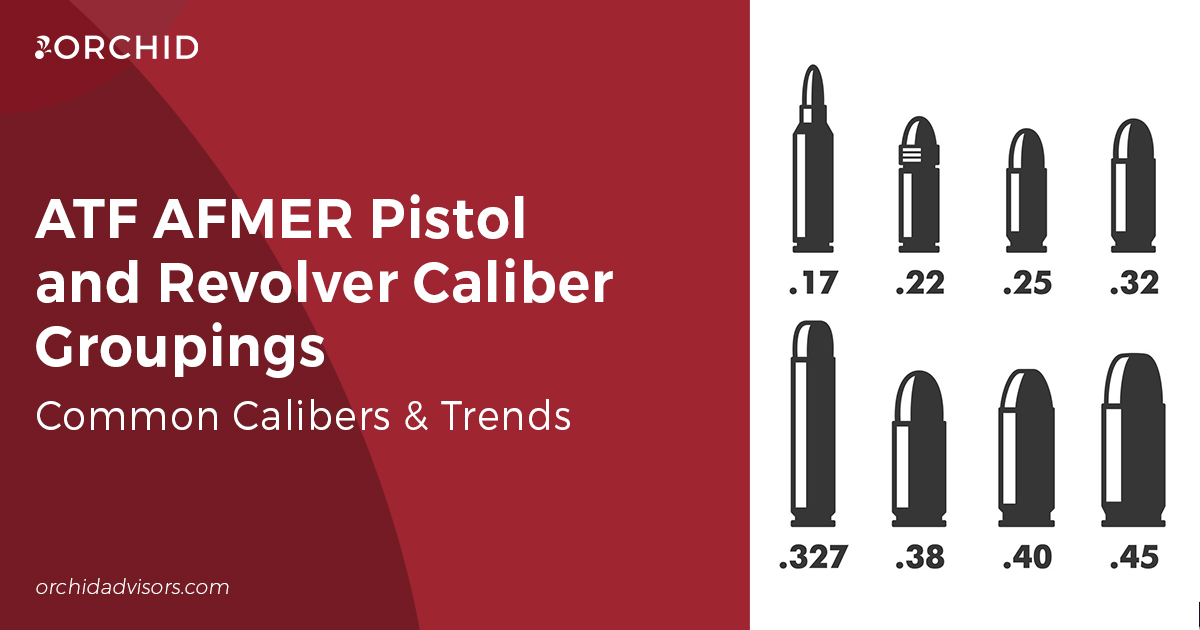Each year, federally licensed firearm and destructive device manufacturers (Type 07 and 10 FFLs) are required to submit a production report of manufacturing and export activity to ATF. Submitted by April 1 using ATF Form 5300.11, the data from the previous calendar year is then compiled and published in the ‘Annual Firearms Manufacturing and Exportation Report’ (AFMER) the following January in accordance with the Trade Secrets Act.
Included in the published AFMER is a summary of total industry production and a breakdown of manufacturing and export data by individual manufacturers. This data is then further broken down by firearm type (Pistol, Revolver, Rifle, Shotgun, and Miscellaneous Firearm) and caliber range for pistols and revolvers manufactured for commerce. However, rather than require manufacturers report totals for every handgun in every chambering, the AFMER divides pistol and revolver calibers into six caliber groupings.
Table of Contents
Pistol & Revolver Caliber Groupings
AFMER Caliber Trends
ATF AFMER Assistance
AFMER Caliber Groupings
Though not inclusive of all handgun calibers and chamberings, the AFMER focuses on popular calibers/cartridges that are commonly and traditionally used in handguns, including large-frame pistols.
Pistols are divided into up to .22 caliber; above .22 and up to .25 caliber; above .25 and up to .32 caliber; above .32 and up to .380 caliber; above .380 and up to 9mm Para.; and above 9mm Para and up to .50 caliber. Revolvers groupings include up to .22 caliber; above .22 and up to .32 caliber; above .32 and up to .38 Special; above .38 Special and up to .357 Magnum; above .357 Magnum and up to .44 Magnum; and above .44 Magnum and up to .50 caliber.
Below is a breakdown of calibers included within each pistol and revolver grouping.
Pistol Calibers
To .22 Caliber
- 45x39mm
- .22 Short / Long Rifle
- .22 WMR
- 56x45mm
- .223 Remington
- 7x28mm
- 6x30mm
To .25 Caliber
- .25 ACP
To .32 Caliber
- .30 Super Carry
- .32 ACP
To .380 Cartridge
- .380 ACP
To 9mm Para Cartridge
- 9x19mm Luger
To .50 Caliber
- .357 Sig
- .38 Super
- .40 S&W
- 10mm
- .45 ACP
- .45 GAP
- .50 AE
Revolver Calibers
To .22 Caliber
- .17 HMR
- .17 Hornet
- .22 Short / Long Rifle
- .22 Hornet
- .22 WMR
To .32 Caliber
- .256 Win Mag
- .32 S&W Short / Long
- .32 H&R
To .38 Special Cartridge
- .38 Special
- .327 Fed Mag
- .38 Short / Long Colt
- .38 S&W
To .357 Magnum Cartridge
- .350 Legend
- .357 Mag
To .44 Magnum Cartridge
- .44 Mag
- .41 Mag
- .44 Special
- .45 ACP
- .45 Colt
To .50 Caliber
- .500 S&W / Mag
- .454 Casull
- .460 S&W / Mag
- .480 Ruger
AFMER Caliber Trends
Since 2000, over 59 million pistols and 12.5 million revolvers have been manufactured in the U.S., including a historic 7.9 million combined handguns in 2021 (the most recent data available).
The historical data referenced below can be found in the ATF’s 2021 AFMER and ‘National Firearms Commerce and Trafficking Assessment: Firearms in Commerce’ (NFCTA).
Pistol Trends
In the last two-plus decades, 39% of all pistols (25 million) have been chambered in 9mm – the most of any caliber grouping. Second highest was “Up to .50 Caliber” with 26% (12 million), followed by “Up to .380 Cartridge” (16%, 10 million), “Up to .22 Caliber” (15%, 8 million), and “Up to .32 Caliber” and “Up to .25 Caliber” at roughly 4% (1.5 million) combined.
In 2021, a record 63.7% of the record 6.7 million pistols manufactured were chambered in 9mm, breaking the previous high set in 2020 (58.3%). Meanwhile, every other caliber grouping saw its share of the pistol market continue to decrease despite year-over-year production increases for rimfire (up to .22) and big bore models.
Additional trends:
- The market share of .22 caliber pistols has decreased 57% since 2004; 9mm has increased 156% in the same period.
- 53% of all “up to .25 caliber” pistols produced in the last 21 years have entered commerce since 2020.
- Except for 2012 and 2020, .380 caliber pistol production has outpaced rimfire production every year since 2008.
- Nearly the same number of .32 caliber pistols were produced in 2001 and 2021, only they made up 8% of all pistols in ’01 compared to 0.8% in ’21.
- More 9mm pistols were produced or entered commerce in 2021 than from 2000-2010 combined.
Revolver Trends
Between 2000-2021, rimfire revolvers have dominated revolver production lines, making up 34% (5 million) of all models. Not far behind are .38 Special (25%, 3 million) and .357 Magnum revolvers (21%, 2.5 million), which combine for 46% of all wheel guns. In the third tier, “Up to .50 Caliber” models account for 10% (1.1 million) and “Up to .44 Magnum” for 8% (850,000). Last is “Up to .32 Caliber,” with just 1% (105,000) production share.
In 2021, more than 780,000 rimfire revolvers were produced or entered commerce – a 30% increase in the caliber grouping from 2020. And like pistols, every other caliber range saw a continued decline in share.
Additional Trends:
- Rimfire revolver production has increased 883% since 2000, growing from 79,000 guns in 2000 to 780,000 in 2021.
- Nearly 3x more .38 Special and .357 Magnum caliber revolvers were produced from 2000-2021 than .32 Caliber, .44 Magnum and .50 Caliber models combined.
- Production share of big bore revolvers (Up to .44 Magnum and Up to .50 Caliber) has decreased 27% since 2001, down from a combined high of 31.8% in 2001 to 4.6% in 2021.
- .357 Magnum revolver production was greater than that of .38 Special from 2000-2005 before being outpaced every year from 2007-2021 (except for 2019).
- More “Up to .32 Caliber” revolvers were produced in 2002 alone than from 2017-2021 combined.
ATF AFMER Assistance
Whether you manufacture 100, 100,000, or 1 million guns a year, the right technology can make tracking firearm production and completing the ATF AFMER easy.
At Orchid, our industry-leading electronic Bound Book solution and ERP integrations enable FFLs to automate operations, eliminate manual dual data entry, audit serial numbers efficiently, track inventory, and maintain accurate and compliant regulated records needed to report firearm production and exportation data. Implementation is simple and API connections can be made for NetSuite, Epicor, Fishbowl and other popular ERP systems. Plus, backed by in-house legal and compliance professionals, our software is trusted by the biggest firearm manufacturers in the U.S.
Contact us today to learn how your FFL can benefit from Orchid’s software manufacturing solutions.
For questions regarding completion of ATF Form 5300.11 (paper or eForm), contact the ATF Federal Firearms Licensing Center (FFLC) at (866) 662-2750 or eforms.admin@atf.gov.








0 Comments